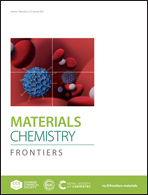Strongly polarized surface electroluminescence from an organic light-emitting transistor†
Abstract
Emissive materials that radiate polarized light are in high demand for a broad variety of light-emitting electronic devices. In organic light-emitting devices—light-emitting diodes and transistors—highly polarized emission from the device surface, the surface emission, can be achieved by the in-plane co-linear orientation of molecular transition dipole moments (TDMs) in the device active layer. Furthermore, such a TDM arrangement strongly alleviates the waveguiding effect, enhancing the performance of the device. In this work, we report the first practical implementation of these ideas in an organic light-emitting transistor. Highly emissive semiconductor single crystals were grown from a thiophene–phenylene co-oligomer 1,4-bis{5-[4-(trimethylsilyl)phenyl]thiophen-2-yl}benzene (TMS-PTPTP-TMS) with trimethylsilyl (TMS) terminal substituents, which promote the in-plane TDM orientation. Organic light-emitting transistors based on TMS-PTPTP-TMS showed ambipolar charge transport with efficient electroluminescence, and the single-crystal devices demonstrated linearly polarized electroluminescence with the polarization degree of 0.78 ± 0.06. The observed polarization properties of both electro- and photoluminescence are in full agreement with the solved crystal structure and the corresponding calculations. Our findings indicate that smart control of in-plane ordered TDMs via molecular packing is a promising approach to designing materials for highly efficient light-emitting electronic devices.

- This article is part of the themed collection: FOCUS: Light-emitting diodes technology


 Please wait while we load your content...
Please wait while we load your content...